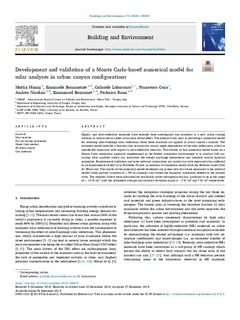| dc.contributor.author | Manni, Mattia | |
| dc.contributor.author | Bonamente, Emanuele | |
| dc.contributor.author | Lobaccaro, Gabriele | |
| dc.contributor.author | Goia, Francesco | |
| dc.contributor.author | Nicolini, Andrea | |
| dc.contributor.author | Emmanuel, Bozonnet | |
| dc.contributor.author | Rossi, Federico | |
| dc.date.accessioned | 2020-01-13T13:17:52Z | |
| dc.date.available | 2020-01-13T13:17:52Z | |
| dc.date.created | 2020-01-09T10:01:27Z | |
| dc.date.issued | 2020 | |
| dc.identifier.citation | Building and Environment. 2020, 170 . | nb_NO |
| dc.identifier.issn | 0360-1323 | |
| dc.identifier.uri | http://hdl.handle.net/11250/2636013 | |
| dc.description.abstract | Highly- and retro-reflective materials have recently been investigated and proposed as a new urban coating solution to reduce the so-called urban heat island effect. The present study aims at providing a numerical model for assessing inter-buildings solar reflections when these materials are applied to urban canyon’s surfaces. The proposed model includes a function that accounts for sunray angle dependency of the solar reflectance, which is specifically important with regard to retro-reflective behavior. The novelty of this numerical model based on a Monte Carlo simulation approach implemented in the Matlab simulation environment is to conduct full raytracing solar analyses which can reproduce the energy exchange phenomena and simulate optical material properties. Experimental validation and inter-software comparison are carried out with measured data collected in an experimental facility in La Rochelle, France, in addition to simulation results from the Radiance-based Diva for Rhino tool. The results of the numerical model developed are in line with the values measured in the physical model (daily percent variation of 1.3% in summer) and within the boundary conditions defined in the present work. The residues, which were calculated for the hourly values throughout the day, are found to be in the range of +/- 10 W/m2, with the arithmetic average and standard deviation equal to – 2 W/m2 and 7 W/m2 respectively. | nb_NO |
| dc.language.iso | eng | nb_NO |
| dc.publisher | Elsevier | nb_NO |
| dc.relation.uri | https://www.sciencedirect.com/science/article/pii/S0360132319308510?via%3Dihub | |
| dc.rights | Navngivelse 4.0 Internasjonal | * |
| dc.rights.uri | http://creativecommons.org/licenses/by/4.0/deed.no | * |
| dc.subject | Solenergi | nb_NO |
| dc.subject | Solar energy | nb_NO |
| dc.title | Development and validation of a Monte Carlo-based numerical model for solar analyses in urban canyon configurations | nb_NO |
| dc.type | Journal article | nb_NO |
| dc.type | Peer reviewed | nb_NO |
| dc.description.version | publishedVersion | nb_NO |
| dc.subject.nsi | VDP::Bygningsmaterialer: 525 | nb_NO |
| dc.subject.nsi | VDP::Building materials: 525 | nb_NO |
| dc.source.pagenumber | 12 | nb_NO |
| dc.source.volume | 170 | nb_NO |
| dc.source.journal | Building and Environment | nb_NO |
| dc.identifier.doi | https://doi.org/10.1016/j.buildenv.2019.106638 | |
| dc.identifier.cristin | 1769021 | |
| dc.description.localcode | © 2019 The Author(s). Published by Elsevier Ltd. This is an open access article under the CC BY license (http://creativecommons.org/licenses/by/4.0/). | nb_NO |
| cristin.unitcode | 194,61,55,0 | |
| cristin.unitname | Institutt for arkitektur og teknologi | |
| cristin.ispublished | true | |
| cristin.fulltext | original | |
| cristin.qualitycode | 2 | |

